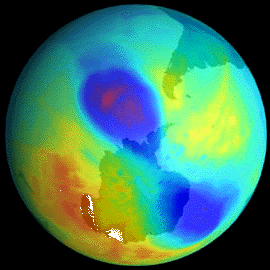
School
of
Chemistry
What is Ozone?Ozone, O3, was discovered in 1839 by a German scientist called Christian Friedrich. It is a perceptibly blue diamagnetic gas which condenses to a deep blue liquid at -112°C. The O3 molecule is symmetrical and bent, with a bond angle of 117°, and the O-O bond length is 1.28Å. Ozone is present in small concentrations throughout the atmosphere. The total overhead amount of atmospheric ozone at any location is usually expressed in terms of Dobson units (DU); one Dobson unit is equivalent to 0.01mm thickness of pure ozone at the density it would possess if it were brought to ground level pressure (1 atm) and 0°C temperature. The normal amount of overhead ozone at temperate latitudes is about 350DU, so if all the ozone were to be brought down to ground level, the layer of pure ozone would be only 3.5mm thick. Ozone absorbs ultraviolet radiation in three main regions known as the Hartley band, the Huggins band and the Chappuis bands. The Hartley band is a wide bell-shaped peak from 200 - 310nm. The Huggins band is a structured region from 310 - 350nm, and the Chappuis bands are found between 450 and 850 nm. Therefore ozone absorbs all of the sun's UV light in the UV-C region (200-280nm), however it can only absorb a fraction of the sunlight in the UV-B region (280-320nm), so 10% to 30% (depending on latitude), penetrates to the Earth's surface. Radiation in the UV-A range (320-400nm) is the least biologically harmful type of ultraviolet light. This is not absorbed by ozone and therefore penetrates to the Earth's surface. |

 |
 |
 |
 |
 |
 |

